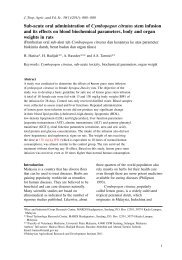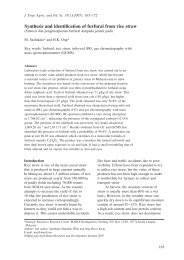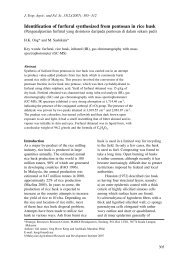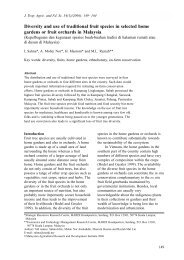Identification and isolation of methyl gallate as a polar ... - Mardi
Identification and isolation of methyl gallate as a polar ... - Mardi
Identification and isolation of methyl gallate as a polar ... - Mardi
You also want an ePaper? Increase the reach of your titles
YUMPU automatically turns print PDFs into web optimized ePapers that Google loves.
Polar chemical marker for Labisia pumila<br />
<strong>and</strong> verification purposes. B<strong>as</strong>ed on<br />
European Medicines Agency (EMEA),<br />
st<strong>and</strong>ardization <strong>of</strong> herbal product is defined<br />
<strong>as</strong> herbal preparation containing a substance<br />
or group <strong>of</strong> substances with known<br />
therapeutic activity which can be used to<br />
st<strong>and</strong>ardise a biological effect or used <strong>as</strong><br />
marker compounds (Zhari <strong>and</strong> Jamshed<br />
2010). Therefore, identification <strong>of</strong> an active<br />
chemical marker from L. pumila extract is<br />
essential for st<strong>and</strong>ardization <strong>of</strong> L. pumila<br />
b<strong>as</strong>ed products.<br />
The objective <strong>of</strong> this study w<strong>as</strong><br />
to isolate a potential chemical marker<br />
for L. pumila which can be used for<br />
st<strong>and</strong>ardization <strong>and</strong> verification <strong>of</strong> the herbs.<br />
In this study, <strong>methyl</strong> <strong>gallate</strong> w<strong>as</strong> isolated<br />
from L. pumila leaves <strong>and</strong> its spectroscopy<br />
data were analysed to prove the identity <strong>of</strong><br />
the compound. In a previous study, <strong>methyl</strong><br />
<strong>gallate</strong> w<strong>as</strong> demonstrated to have high<br />
antioxidant activity <strong>and</strong> cytotoxic towards<br />
cancer cell lines (Yong et al. 2005). Various<br />
types <strong>of</strong> bioactivities were also reported<br />
such <strong>as</strong> antimicrobial, sucr<strong>as</strong>e inhibitor,<br />
collagen<strong>as</strong>e inhibitor <strong>and</strong> used <strong>as</strong> treatment<br />
for enteritis (Chaubal et al. 2005).<br />
Materials <strong>and</strong> methods<br />
Sample preparation<br />
Three kg <strong>of</strong> fresh L. pumila leaves were<br />
collected from MARDI Kluang station <strong>and</strong><br />
ground to 2.0 mm particle size.<br />
Preparation <strong>of</strong> methanol extract<br />
The fresh L. pumila leaves were ground to<br />
2.0 mm particle size <strong>and</strong> soaked in 100%<br />
methanol (MeOH, which is close to aqueous<br />
extract) for 4 days at room temperature<br />
after which the extract w<strong>as</strong> decanted (Mohd<br />
Nazrul Hisham et al. 2010). The plant<br />
material w<strong>as</strong> replenished with fresh MeOH<br />
<strong>and</strong> the same extraction procedure repeated<br />
twice. The extracts collected from each<br />
soaking were pooled <strong>and</strong> concentrated to<br />
dryness using a rotary evaporator to obtain<br />
the crude extract.<br />
280<br />
Isolation <strong>of</strong> <strong>methyl</strong> <strong>gallate</strong><br />
The crude methanol extract <strong>of</strong> L. pumila<br />
w<strong>as</strong> then resuspended in distilled water<br />
<strong>and</strong> solvent partitioned with hexane,<br />
dichloromethane (CH 2 Cl 2 ), ethyl acetate<br />
(EtOAc) <strong>and</strong> butanol (BuOH) (Yong et al.<br />
2005). Ethyl acetate fraction (10 g) w<strong>as</strong><br />
first subjected to normal ph<strong>as</strong>e column<br />
chromatography (CC). Elution started with<br />
100% chlor<strong>of</strong>orm (CHCl 3 ) followed by<br />
mixtures <strong>of</strong> CHCl 3 :MeOH <strong>of</strong> incre<strong>as</strong>ing<br />
<strong>polar</strong>ity to yield a total <strong>of</strong> ten fractions.<br />
B<strong>as</strong>ed on similar TLC patterns,<br />
fractions 3 to 5 (4 g) were recombined <strong>and</strong><br />
subjected to normal ph<strong>as</strong>e open column<br />
chromatography using 100% chlor<strong>of</strong>orm<br />
(CHCl 3 ) <strong>as</strong> mobile ph<strong>as</strong>e, followed by<br />
mixtures <strong>of</strong> CHCl 3 :MeOH <strong>of</strong> incre<strong>as</strong>ing<br />
<strong>polar</strong>ity. Ten fractions were collected, <strong>and</strong><br />
b<strong>as</strong>ed on similar TLC patterns, fractions<br />
7 to 10 (2.5g) were recombined <strong>and</strong><br />
subjected to open mini column normal ph<strong>as</strong>e<br />
chromatography using 100% chlor<strong>of</strong>orm<br />
(CHCl 3 ) <strong>as</strong> mobile ph<strong>as</strong>e, followed by<br />
mixtures <strong>of</strong> CHCl 3 :MeOH <strong>of</strong> incre<strong>as</strong>ing<br />
<strong>polar</strong>ity to obtain 20 mg <strong>of</strong> white crystals.<br />
M<strong>as</strong>s analysis<br />
M<strong>as</strong>s spectra were recorded on a Shimadzu<br />
GC-17A g<strong>as</strong> chromatography m<strong>as</strong>s<br />
spectrometer (GCMS). The GCMS w<strong>as</strong><br />
equipped with a direct injection probe<br />
(DI-probe) to analyse pure samples without<br />
p<strong>as</strong>sing through the capillary column. The<br />
pure isolated compound (in white crystal<br />
form) w<strong>as</strong> subjected to m<strong>as</strong>s spectroscopy<br />
analysis <strong>and</strong> the m<strong>as</strong>s spectrum elucidated to<br />
support the NMR analysis for determination<br />
<strong>of</strong> the chemical structure.<br />
Nuclear Magnetic Resonance (NMR)<br />
analysis<br />
The pure white crystals were placed on<br />
top <strong>of</strong> the probe <strong>and</strong> subjected to 1 H, 13 C<br />
NMR <strong>and</strong> two dimensional analyses such<br />
<strong>as</strong> Heteronuclear Multiple Bond Correlation<br />
(HMBC). The different spectrum <strong>of</strong> the<br />
isolated compound were recorded on a<br />
Varian Unity Inova (500 MHz) equipped






